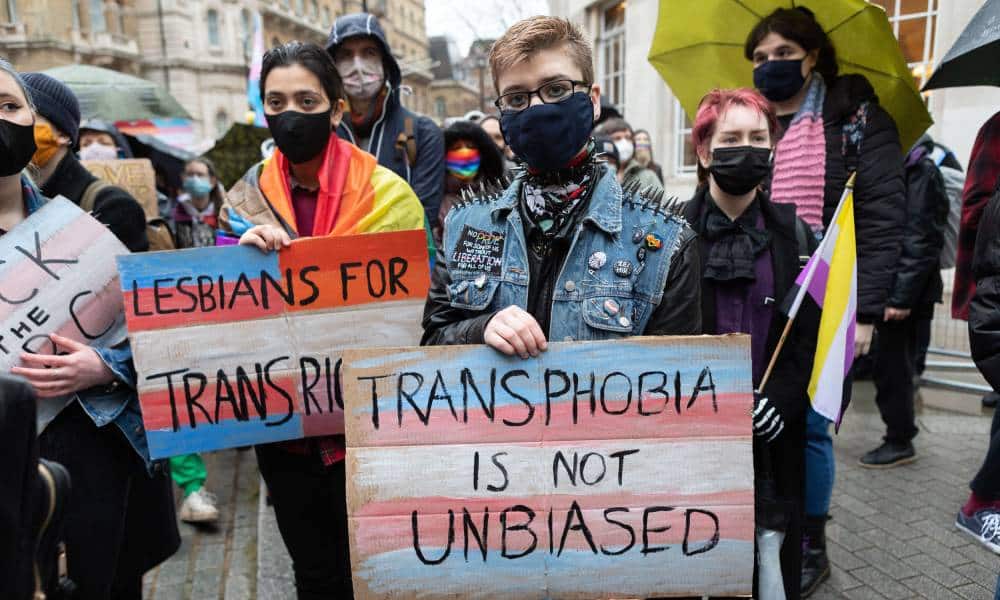
The report, published by Global Action for Trans Equality (GATE), mapped how the anti-trans movement is mobilising the UK.
GATE said the report, part of the advocacy organisation’s broader mapping project, focused on the UK as one of the “global hotspots” where anti-trans movements have “enjoyed increased efficacy in the past few years”.
The project mapped 368 anti-trans and linked actors in the UK and internationally, including figures in the right-leaning media, UK religious right, US religious and neo-conservative right, trans-exclusionary feminists/LGB actors, and the alt/far-right.
These people were linked to campaigning groups, individuals, publishers, media organisations, commentators, authors, publications, political parties and groups, social media platforms and more.
The report analysed the 1,036 relationships between these figures and how they interacted with each other. Their relationships could be through activities such as employment, campaigning, interviews and panels, or co-authorship and collaborating in legal funds.
The report found anti-trans movements in the UK have become “significantly larger, more visible and more effective” since 2015/2016 to the present day. GATE said the organisation saw a “dramatic increase in anti-trans content and activity in UK media and politics” starting in 2015.
It found there is an “important driving role played by right-wing groups” and that the actors in these groups “interlink with much of the UK media, commentariat, wider political class and traditional conservative groups”. They were also linked with “parts of the left-leaning media and political class”.
GATE saw there had been a “marked rise in anti-gender mobilisations” that coincided with efforts by trans and broader LGBTQ+ campaigners pushing for legal and policy reform. Notably, this included efforts to “prioritise advocacy around legal gender recognition” from 2015.
At the same time, GATE saw there was “rising influence and activities” within the right/media on trans rights and related issues in the UK.
People in these groups constituted a “large coalition of the right/media” that is the “most influential” block in the mapping of how the anti-trans movement has mobilised across the UK.
“This group is closely enmeshed with (and also constituted by) key conservative and centrist media, and a smaller range of left-wing media,” the report said. “[This group] is the most populous group on the map and has the highest density of social relations.”
The report continued: “They are by far the most influential group, even without factoring in their tremendous power to set the media agenda, reach audiences, and influence policy and legal change. Indeed, many of these actors actually are media, government, and wider policy-makers (eg key UK think tanks, NGOs, and foundations linked to policymaking).
“The vast majority of these actors were not producing content about trans issues prior to 2015.”
The report found many actors “share a zerosum conception of rights” even though many seem to have “very different” or “even radically opposing” political agendas in many respects. This conception included the predominant belief “for one community’s rights to be respected and protected, another community must be excluded from rights protections”.
GATE found all groups in the mapping were “generally, anti-intersectional” and “critical of younger social movements”. The report concluded many actors believe they are “true victims” of an “excessively liberal new status quo”.
“In this and other cases, we can also see that anti-gender mobilisations directly attack target communities – sending marginalised communities into localised, often bruising battles, and away from a focus on broader drivers and conditions for change,” the research found.
It added: “Indeed, oftentimes, anti-gender frames invoke a fearful, austere, and limiting world in which, apparently, rights are in short supply, dangerous characters and coercive industries lurk in the shadows, and ‘our’ most basic freedoms are under attack on all sides.”
GATE concluded few people benefit from “this way of understanding politics, society, culture and economics”. As such, the organisation said it “amounts to a race to the bottom”, which “places a wide range of rights at risk”.
The mapping highlighted an incentive for trans and allied groups to look beyond the current “limiting line of sight” and the “negative focus and effects of backlash” to potential new alliances.
The report also said a need to develop campaigning approaches which can “de-centre, disrupt” and speak past the “core messages of anti-gender actors” – which rely “strongly on fear based messaging and anger-based mobilisation”.
“This could include alternative agenda (and role) setting and framing approaches, considering a focus on hope-based communications, material needs of trans communities, and the importance of collaboration and solidarity,” GATE said.
Trans and allied groups should address the fearmongering and disinformation through “supporting fact-checking resources, effective rebuttal and improved standards” among reporters.
